As is often the case, the story of the pipe organ at St. Stephen-in-the-Fields Church in Toronto is very much tied in with the story of the building itself. The ups and downs of the instrument certainly coincide with those of the parish. The Church is located in the West – Central part of Toronto’s inner city. The address is 103 Bellevue Avenue, but the entrance currently in use is on College Street, a major thoroughfare that runs east and west. If you are looking for the building, it is located on the south side of College Street, between Spadina Avenue and Bathurst Street. It is easily reached by public transportation, with the College streetcar close by.
St. Stephen’s was built by the Dennison family, wealthy landowners whose home, Bellevue House, was near the site of the Church. Constructed of brick, the building was designed by the well-known ecclesiastical architect, Thomas Fuller who later moved to Canada’s capital city, Ottawa, known, when the Church was built in 1858 as Bytown. The original building consisted of just the nave of the present structure. So far I have been unable to get any information about the organ then installed, except that it stood on a small gallery over the West door.
Less than ten years after it was built, the Church was gutted by fire. The Dennison family as patrons of St. Stephen’s had the building reconstructed. As much as possible of the original became the Nave, and a large Chancel and Sanctuary, with a Lady Chapel were added to the East end of the building. The Chapel was (and is) located on the North side of the Chancel, and a spacious organ chamber was built opposite. The chamber was designed well, and is entirely within the building. There is a large opening into the Chancel, and another was provided into the South aisle, the display pipes forming a rerados for the Altar in another chapel located in the aisle.
Architecturally the Church has a very ‘English’ look, although as one who lived for a time in England, I never saw a Church, urban or rural, that quite matched St. Stephen’s. While it has been described as a Gothic Revival structure, that is not entirely accurate, and, in fact, it shows some of the attributes of an ‘A” frame building. The walls of the Nave are low, with the windows set into dormers while the roof rises to a ridge far higher than the walls. After the fire, the broad Nave seated some 900 people until recent changes. There was a spacious aisle on each side separated from the central Nave by rows of pillars and Gothic arches. The ‘new’ Chancel and Sanctuary are lofty, and a display of 16′ organ pipes is easily accommodated in the case. The acoustics were excellent, and are still very good, even though drastic changes have been made to the structure. More about that later. Still, the exterior has been preserved, and the structure declared of historic and architectural importance.
Again no information is currently available about an organ in the Church until the present one was installed in 1906. There was a large harmonium in the Chapel on the South side of the Nave, and this did have enough power to accompany hymns when the pipe organ failed to function. That instrument has since disappeared.
The Church’s location today is highly urban and inner city by nature. When the Dennison family built it, St. Stephen’s was in the country, and thus St. Stephen-in-the-Fields. The fields were real. While the Church did have a few wealthy parishioners, it was never a wealthy parish, the building being rather grand for its congregation. The implications as the city grew and changed were obvious for the future. A large and expensive building to be maintained without a large budget to support it. Thus as time went on, the congregation found it necessary to cut financial corners when it came to furnishing and maintaining the building. This restraint applied to the pipe organ.
In 1888, George Ryder, organ builder from Reading, Massachusetts, was contracted to build a new instrument for New Richmond Methodist Church on McCaul Street, less than a mile east of St. Stephen’s. It was a fairly large instrument for its day, two manuals and some 27 ranks of pipes. The action, of course, was tracker (mechanical) with Barker lever (pneumatic) action for the larger pedal stops. The organ was Ryder’s Opus # 149. While romantic in nature, the Ryder organ did have some nicely developed harmonics, and was much brighter and fiery in sound than many other North American instruments of the time. Rather than following the French or English tonal pattern Ryder based his work on the German model.
In 1906, the New Richmond Methodist Church, due to a major change in demographics, was sold to a Jewish congregation to be used as a synagogue. The new owners had no need of the organ, and it was put up for sale. The people of St. Stephen’s purchased it from the Methodists. Just before it was to be moved, a dispute over the ownership of the instrument arose between the Methodists and the new owners of the building. Worried that the fine instrument they had purchased might not come to them after all, many of the men from the congregation spent the night outside the former Methodist Church, to ensure that it was not touched by anyone else. It was not. In the morning the men from Breckels and Mathews, a highly reputable firm of organ builders, arrived, the organ was dismantled and removed.
Breckels and Mathews made some fairly major changes in order to suit the instrument to its new home, providing a new key desk and key action, adding a couple of ranks and rearranging the pedal pipes and some of the Great Organ. A display of 16′ Open Diapason pipes, painted and decorated in rather Victorian fashion formed the façade which can still be seen. Other decorated pipes from the 8′ pedal stop which had been on display in the former Church were installed inside the chamber. The disposition was Great 10, Swell 11 and Pedal 3. The façade contained pipes from the Pedal Open Diapason 16′ and the bottom octave of the Great Open Diapason 8′, with the unenclosed Great immediately behind, and behind that the Swell, with a walkway between the two divisions. The Pedal Bourdon 16′ and Violin ‘Cello were located to the west of the manual chests. The organ remained much the same as this until 1942.
When first installed in St. Stephen’s, the organ, now bearing the name-plate of Breckels and Mathews, was hand pumped, and the indicator lines and instructions are still to be seen. At some point, however modern technology caught up with the instrument and a hydraulic blowing system was installed. The remains of this are still in the basement under the Chancel. The water-powered blowing system seemed to work quite well in the warmer weather, but it had a tendency to freeze in winter, rendering the organ speechless.
In the 1920’s a major advance was made under the leadership of the Rev’d. Canon James Ward, a priest who was also an accomplished musician, writer and pioneer in may fields. At Canon Ward’s insistence the hydraulic blowing system was retired and the first electric blower installed. The feeders were removed, but the main bellows, 7-feet square, was retained as the reservoir, and is still in use today.
Meanwhile the musical life of the parish thrived. St. Stephen’s became known for its fine choir and the distinguished musicians who sought and held the position of Organist and Choir Master. The organ itself became well known, and its unique sound was thrilling. Powerful reeds with lots of fire, assertive yet not muddy diapasons, romantic strings and clear flutes all blended into a bright chorus. A joy to hear and to play, at least when not plagued by mechanical problems. Outstanding organists were willing to put up with its idiosyncrasies, for the sake of its glorious sound.
The year 1942 brought the first major change in the organ since the days of Breckels and Mathews. In that year the mechanical action was electrified. The Ryder chests were becoming unreliable…(they still are!) and the heavy tracker action and long draws on the stop knobs had little appeal to the organists who had learned their art on instruments by Warren and Casavant, and the more recent work of Breckels and Mathews, to name a few builders. It was the modern age, and new technology must be applied to the organ. After all, this was a Church of the Twentieth Century — Canon Ward had pioneered Church radio broadcasting from St. Stephen’s. This medium made the voice of the priest and that of the organ familiar to many thousands across the country and into the United States. In keeping with the times, the organ was electrified.
Sadly the parish did not have the funds to have the work done by one of the leading builders, and the Franklin Legge Organ Company was called in. The original Ryder chests, pull downs and pallets were retained, in spite of growing unreliability due to wear and splits occurring in the sound boards, exacerbated by dryness during the heating season. The sliders were also kept.
Mr. Legge installed electropneumatic stacks under the chests to operate the pulldowns and pallets. These were quite efficient, and of his own design, but they had one problem. They needed higher wind pressure for proper operation. Similar devices were attached to the sliders, and these remain in use today.
A new and rather impressive draw-knob console was installed under the façade, facing West. This part of the organ was definitely a relief for the organist with its light touch and adjustable pistons. Now, too, the organist could keep his eye on the choir without relying on a mirror and a twisted neck.
When the conversion was complete, a new 49-note Celeste had been added to the Swell, with its own electropneumatic wind chest. That chest still functions reliably…sometimes the only stop on the organ that can be caused to function!
Back to the wind pressure problem. In order to operate his electropneumatic action, Franklin Legge raised the wind pressure noticeably, resulting in a slightly forced tone, and a rise in pitch of almost a semitone. This situation continued until 1971.
In spite of the problems mentioned, the St. Stephen’s organ continued to be a favourite among musicians and the musical tradition continued. The organ was in this state when I began taking lessons on it with Ian Galliford and later George Coutts. It was a truly thrilling instrument to play, and one could become lost in its majesty. Hours at the console passed like minutes. It always seemed that I had just got there to practise when it would be time to go home. Hours would have passed, unnoticed. That, of course, applied only when it worked.
During the 1960’s, the organist was the very talented Peter Roe, who is not only an accomplished church musician and recitalist, but also a talented organ builder and technician. During his tenure, Peter made a number of tonal improvements and enlarged the organ to three manuals, moving the console across the Chancel at the time. When Peter left, the organ had the following specifications:
| Great |
Swell |
Pedal |
Couplers
(tablets) |
| *Open Diapason 8′ |
*Bourdon 16′ |
*Open Diapason 16′ |
Great to Pedal |
| *Dulciana 8′ |
*Open Diapason 8′ |
*Bourdon 16′ |
Swell to Pedal |
| *Hohl Flute 8′ |
*Stopped Diapason 8′ |
*Violin ‘Cello 8’ |
Choir to Pedal |
| *Principal 4′ |
*Salicional 8′ |
+Trombone 16′ |
Swell Super to Pedal |
| *Harm. Flute 4′ |
**Voix Celeste 8′ |
|
|
| *Twelfth 2 2/3′ |
*Octave 4′ |
Choir |
Swell Sub to Great |
| *Fifteenth 2′ |
*Piccolo 2′ |
|
Swell to Great |
| *Clarinet 8′ |
*Mixture II rks |
+Stopped Flute 8′ |
Swell Super to Great |
| Trumpet 8′ |
*Oboe 8′ |
+Piccolo 2′ |
Choir to Great |
|
*Cornopean 8′ |
|
Great Super Octave |
|
*Tremulant |
|
Swell Sub to Choir
Swell to Choir
Swell Super to Choir |
Draw-knob console with couplers on tablets above Swell
Manuals 61 notes Pedals 30
Action: Mechanical pull downs with ep stacks. Slider stop action
Balanced Swell Pedal – 5 stage motor
Balanced Crescendo Pedal
6 adjustable thumb pistons
3 reversible thumb pistons
Great to Pedal toe reversible
Full Organ reversible (toe) |
|
*Original pipes from 1906. Mainly Ryder, but some possibly Breckels and Mathews.
**Added by Franklin Legge in 1942
+donated and installed by Peter Roe |
Peter Roe used the 1942 Franklin Legge console, adding the Choir manual and controls.
It is interesting to note that the Clarinet on the Great is a rather powerful stop, not noted for the mellowness normally associated with the name. There are some Krumhorn characteristics. It is a useful Great reed, and does not suffer from not being under expression as one might expect.
In 1971 an attempt was made to improve the reliability of the organ, and it was overhauled by John Fyall and Son. But once again cost was a factor, and the old Ryder chests and action remained. The organ was dismantled, the pipes removed and complete cleaning was done. The Legge electropneumatic stacks were replaced by Kimber-Allen pull-down magnets. (The Legge action to run the sliders was retained.) All the metal pipes were sleeved for easier tuning, affecting the tone to some degree, but not too seriously. The big tonal change came when it was possible to reduce the wind pressure. Pitch has been restored to normal A=440, and the sound seems less forced then before.
About this time the Franklin Legge console was replaced by a 1928 Casavant one, removed from St. Jude’s when that Church was closed. It is interesting to note that when this was done the stop names were not changed on the draw-knobs, and these were hooked up to stops with the closest sound. Thus the Great Dulciana now plays when the Gemshorn is drawn, Swell Open Diapason is now a Violin Diapason, the Piccolo has become a Flautino, and the Mixture II masquerades as a Mixture III (an effect that is achieved when the ‘Flautino’ is drawn with it.) The Swell Octave 4′ is now known as the Spitzprincipal 4′.
The last time I heard the organ and played it was in 1970, when it could still be described as magnificent, although many stops were slow to act, and runnings occurred among the Swell ranks on occasion, caused by the deteriorating Swell soundboard. That situation remains as I write.
Back in 1947, organist Ian Galliford described the instrument as ‘An atrocious organ. Wonderful sound, but atrocious!’ The notorious unreliability of the old Ryder chests was the motivation for this description. Some of Franklin Legge’s work added to this situation.
Time has passed. Back when I was a child Canon Ward, a family friend and godfather, would sometimes refer to his Church as, “Not St. Stephen-in-the-Fields, but St. Stephen-in-the-Red.” At times I wonder if it might not also be called, “St. Stephen-on-the Rocks.” That suits both my sailing hobby and predilection for a certain Scottish beverage served over ice…
In June of this year I was invited to examine the organ and make recommendations for its future, as well as undertaking some urgent repairs to make it usable, at least. Although thinking of retiring from active organ repair and maintenance to concentrate on my writing and the Tall Ship Canada magazine of which I am executive editor, the prospect of returning to St. Stephen’s held great allure. Because of Canon “Uncle Jim” Ward, I had been attending the Church off and on since I was a very small child. Here was the pipe organ that I had first played, and the Church I had attended after returning from England. It is the one in which my wife and I were married. Of course I went! The project is now under way.
My return to St. Stephen-in-the-Fields after thirty years was a shock. The Parish Hall and Rectory were gone, replaced with an apartment building. The Convent and Church Home for the Aged closed, the nuns having fled the inner city to open a new facility called Cana Place in newer part of the city. Still, one of the former Church buildings, now involved with social services is called St. Stephen’s House. What I saw inside the Church itself was hard to believe.
In the middle of the Nave a complete building has been constructed, at one time housing a clinic and providing some rental income for the parish. Its tenants have long since departed. In addition to this structure, a wall now divides the Nave in half, and the Gothic arches of the aisles have been walled up, creating offices and classroom space.
The traditional furniture has gone from what is left of Nave, Chancel and Sanctuary. A few stacking chairs near the Chancel steps replace the pews for almost a thousand people. The choir stalls are gone, as are the sedilia. The High Altar is now on wheels, and moved forward, its former place of honour an empty space. The rerados is gone. The organ case remains…but not the same! The 16′ Open Diapason still stands proudly in place, pipe tops reaching toward the roof beams. But there is something new! Beneath the mighty Diapason is a smaller front of painted eight-foot pipes. Reminiscent of a Continental Positive, or perhaps an English Choir or Chair, but that is not the case. I know those pipes of old. The pedal eight-foot stop has moved outside the chamber, and now is silent. I shake my head in dismay.
To the console. I turn the key and the organ wheezes into life. The Casavant console is new to me. I draw two stops on the Choir, and touch the keys. Nothing. No sound. I try the other knobs to see if they control the pipes my friend Peter had installed. The same. No sound at all.
Next, the Swell. I draw the strings and promptly there is a squeal as many pipes sound forth. Runnings. The old Ryder chest has not improved with passing years! The Great has runnings too, and ciphers. With caution some ranks can be persuaded to behave. The remnants of past glory sound forth. Briefly. Time to step inside the chamber. I do that.
A horror! Dust and dirt on every surface, in some places inches deep. Some pipes are partly filled and cannot speak. Stepping in front of the Great chest to where the Choir once stood, I find the space is empty. Chest and pipes are gone! Nobody can tell me when or where. Then around behind the Swell…the old opening arch into the Nave has been walled up. The eight-foot pedal stop is gone, chest and all. A few pipes form that front I’d seen, the rest have disappeared. And everywhere the dirt. Such terrible neglect. On one wall there is a wind chest mounted, one of Franklin Legge’s, and it was not there before. The inscription on the wood suggests a string, ‘Salic.’ I read, a Salicional. But the pipes are of a principal. What’s this? And then I see. The wind trunk has been disconnected and the wires pulled away. There’ll be no sound from this, I think.
Further examination shows more dirt, loose, hanging wires. Dirt-filled pipes. Dirt everywhere. We set to work.
Cleaning first. We uncover hidden wires buried in the dust of decades. We fill a 10-gallon shop vac many times. But let’s try to make it sound. The blower works and the rectifier produces DC current. Some pipes can speak. We manage to use the Swell Bourdon 16′ to draw off unwanted wind, and the Swell Can play! At last the grandeur I recall comes back, as the Cornopean caps the chorus…but all is out of tune. Oh well! The Mixture is missing! We find it later and bring it back to life. Most of the Bourdon pipes are gone. No great loss…a muddy stop as I recall, and we have enough left to relieve the runnings. Back to the console. Coupling, with octaves up and down, to Great and Choir we can achieve some nice effects. Play a solo against the Swell itself, or build another chorus.
The Great is temperamental. At times for no apparent reason the pull down magnets come to life and wrong notes sound. Close the Swell box, and the Great responds with discord. Sometimes. The trick is to know just when.
And so it goes. The Pedal Bourdon has most strange behaviour! At times when on, more discords from un-drawn reeds. I shudder, and decide, “Swell to Pedal” and those few Bourdon pipes are a help.
Yes…in moments of good fortune, the sound is there. The majesty has not fled, at least not entirely.
We continue trying to make this organ usable at least. A friend who once designed nasty things for Litton Industries, guidance systems and internal missile circuits, has offered some electrical help. He is a wizard. And I form a plan.
At first the thought is to replace the entire thing, buy a used organ in good repair and place it here in St. Stephen’s. Yet that’s not what we want. Can we save the wondrous sound of old and bring the machinery back to life? So let it be.
The answer is new chests and action. The Ryder chests must go. The console will serve for now, the blower is old but fine and the rectifier can still be used. The swell box is effective and in good shape. The Casavant chest where the Trombone stands is good.
A friend from Temple Organs in Missouri offers hope…a price the Church can possibly afford. We’ll work toward that. We’ll continue striving to keep the poor old beast alive for now, a year or two or maybe three, and then!
The Ryder’s glorious sound will one day return. Modern pitman chests and action. New wiring throughout. It will be a new organ, good for another hundred years or more, with proper care. And the sound that George Ryder, Breckels and Mathews and Peter Roe developed over years will be back. Best of all, perhaps, will be the chance to play it without fear of what may be going to happen next! This time St. Stephen’s has the chance to do it right, and win! The future looks bright.
I’d love to play it and trust it before I die. Let’s dream the possibledream!
Addendum: While working at St. Stephen’s on Friday (10/22/2000), I discovered an additional disaster:
The Franklin Legge organ company added electropneumatic stop action in order to operate the sliders. This consists of a large unit fastened to the end of the chest, and made up of two sections. The lower section contains the action which is much the same as that in a ventil chest. This is connected via wires from the pneumatics to the upper, larger box which contains the complex system of levers which actually move the sliders in and out. Between the upper and lower boxes is a space of about half an inch. The stop action box for the Swell is just outside the door into a vestry… Someone had decided the narrow space between the two parts of the action was ideal for holding a wire coat hanger. Yes! They had straightened out the hook at the top to go into the space between the two sections of the action, and managed to find the tiny hole above a pneumatic pouch. As a result, the Swell 8′ Diapason no longer sounds. Because of the installation and complexity, we are looking at about 8 hours’ work to dismantle, re-leather the pouch and reassemble the stop action. Whew! I have put warning signs in the area, now, but I guess that really means locking the stable door after the horse was stolen! It seems that most people, even organists in many cases, are unaware of the complexity of the instrument…in fact to many the inside of a pipe organ looks much more like a collection of junk than the interior of a musical instrument!
Notes on the Casavant Console
The 1928 Casavant console at St. Stephen’s Church felt very familiar when I sat down to play. At first that seemed not at all unusual, since I have always found the consoles by that builder very comfortable to use, regardless of the design period. As mentioned in my article previously, a very reliable source had informed me that this console had come from St. Jude’s Church, Roncesvelles, Toronto. That building had become redundant, and was closed by Diocesan authority. At one time I had tried to acquire the console for the organ I was playing at the time, but was told it had already been sold when the organ was broken up for parts. I settled for a 3-manual Austin console for my Church, and thought no more about it until recently.
While playing at St. Stephen’s, I did notice that the console had provision for forty stops, while the instrument at St. Jude’s had been a smaller one, about 20-25 stops total. Still, memory fades!
Shortly after becoming a member of the Organ Focus site and publishing my first two articles, I received an email response from Andrew Mead, a talented organ builder who lives not far from my home, with further details on St. James’ Cathedral and a note about St. Stephen’s. Andrew identified the console at the latter as coming from St. Clement’s Church, Eglinton, (North Toronto.) This made a lot of sense. It also opened up more vistas, both for this site and in my memory.
While the organ in St. Stephen’s was the first I ever played, that at St. Clement’s was the second, and the first on which, as a teenager, I ever played for a service. This all reminds me of another instrument that may well be described here. The St. Clement’s organ, a Casavant, had major work done in the seventies, including a new console and a powerful unenclosed positiv division in the Chancel. The organ is being totally rebuilt this year by Casavant, and should prove interesting.
Anyway, no wonder the console felt so familiar to me! Many thanks to Andrew Mead for his interest and very useful information. Andrew also added to my knowledge of the St. James Cathedral organ, one which he is now maintaining.
© 2000 Ross Trant
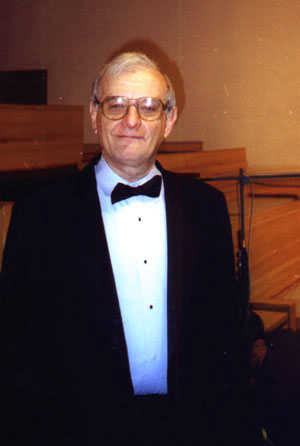
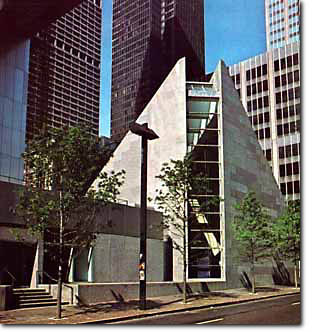 The minimalist modern architecture of St Peter’s was a perfect background for the highly spiritual music of Bach. Having never visited St Peter before, I was struck with it’s architect’s flight of imagination. I certainly have never seen a church where the sanctuary was below ground level, with ceiling windows facing the street. Several people were glued to the glass during the performance, and that created a feeling that the organ was speaking not only to us, sitting below, but also to the people outside, and to the sky, and to the entire city.
The minimalist modern architecture of St Peter’s was a perfect background for the highly spiritual music of Bach. Having never visited St Peter before, I was struck with it’s architect’s flight of imagination. I certainly have never seen a church where the sanctuary was below ground level, with ceiling windows facing the street. Several people were glued to the glass during the performance, and that created a feeling that the organ was speaking not only to us, sitting below, but also to the people outside, and to the sky, and to the entire city. BINGEN – It’s almost unbelievable: In spite of little advertising, even “unspectacular” organ concerts find their audience. Indeed, the listeners in the well-attended Catholic Church in Büdesheim were more than rewarded.
BINGEN – It’s almost unbelievable: In spite of little advertising, even “unspectacular” organ concerts find their audience. Indeed, the listeners in the well-attended Catholic Church in Büdesheim were more than rewarded.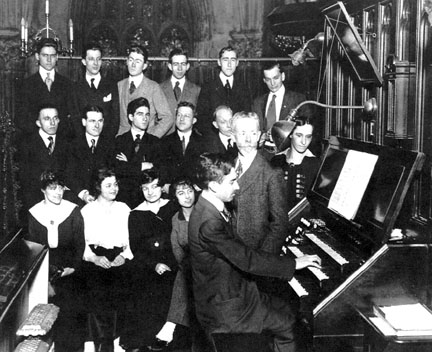
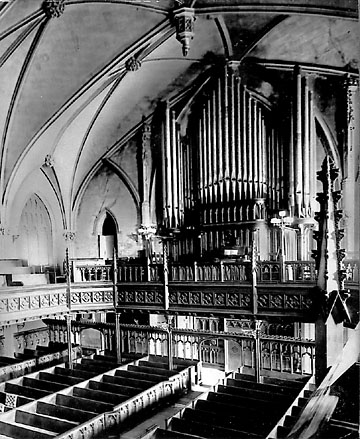 The impressive Roosevelt Organ was used until 1918, when it was replaced with an E. M. Skinner Organ located in the newly constructed choir loft in the front of the church. The Skinner, which was rebuilt in 1928, was eventually replaced in 1964 with the current Austin Organ, which incorporates some pipework from the Roosevelt and Skinner instruments. This past year, this instrument was cleaned and tonally regulated by the firm of Glück Orgelbau, Inc.
The impressive Roosevelt Organ was used until 1918, when it was replaced with an E. M. Skinner Organ located in the newly constructed choir loft in the front of the church. The Skinner, which was rebuilt in 1928, was eventually replaced in 1964 with the current Austin Organ, which incorporates some pipework from the Roosevelt and Skinner instruments. This past year, this instrument was cleaned and tonally regulated by the firm of Glück Orgelbau, Inc.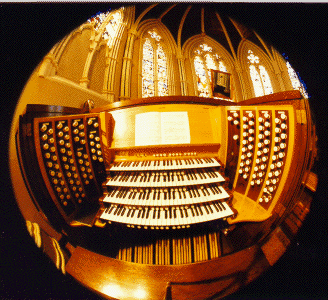 The ‘voice’ of the Cathedral Church of St. James was built in 1888 by Samuel Warren and Sons. The four-manual Walker console arrived in 1979, when the 97-rank instrument was already almost a century old. Extensive rebuilds were undertaken in 1916, 1936 and 1967 by Casavant. In more recent years further upgrades were accomplished, including the addition of a 32-foot reed on the large pedal organ. This is, perhaps, my favourite Toronto pipe organ. Rather romantic in nature, it has the characteristics of an English Cathedral organ, yet with something of a French touch in the voicing of many of the reeds. It handles well the works of Franck, Vierne, and other French composers, as well as the works of Bach and the music associated with the English Cathedral. How do you describe just how an organ sounds? I am not really sure. I hope these few remarks will give you some idea of the majesty of this one. If you are lucky, you will arrive when the organ is in use. If you are very lucky you may have the good fortune of playing. Powerful and exciting, yet capable of soft whispers, too. A wondrous sound in friendly acoustics. The spirit of Samuel Warren lives on, along with touch of the Casavant brothers, and Stephen Stoote tonal director in the thirties and beyond.
The ‘voice’ of the Cathedral Church of St. James was built in 1888 by Samuel Warren and Sons. The four-manual Walker console arrived in 1979, when the 97-rank instrument was already almost a century old. Extensive rebuilds were undertaken in 1916, 1936 and 1967 by Casavant. In more recent years further upgrades were accomplished, including the addition of a 32-foot reed on the large pedal organ. This is, perhaps, my favourite Toronto pipe organ. Rather romantic in nature, it has the characteristics of an English Cathedral organ, yet with something of a French touch in the voicing of many of the reeds. It handles well the works of Franck, Vierne, and other French composers, as well as the works of Bach and the music associated with the English Cathedral. How do you describe just how an organ sounds? I am not really sure. I hope these few remarks will give you some idea of the majesty of this one. If you are lucky, you will arrive when the organ is in use. If you are very lucky you may have the good fortune of playing. Powerful and exciting, yet capable of soft whispers, too. A wondrous sound in friendly acoustics. The spirit of Samuel Warren lives on, along with touch of the Casavant brothers, and Stephen Stoote tonal director in the thirties and beyond.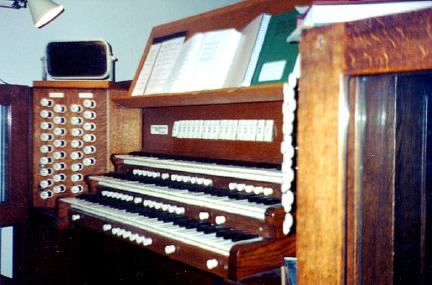 Considered by many to be the key parish in the Anglo-Catholic movement within the Anglican Diocese of Toronto, the Church of St. Mary Magdalene, in the West-central area of the city, has a powerful musical tradition. Many important names have been attached to its musical leadership, but perhaps the greatest of these was Healey Willan, composer, conductor, organist and choir director. When Dr. Willan left his post at St. Paul’s, Bloor Street, he began his career at St. Mary Magdalene’s in 1921 and continued there until his death in 1968. Under Dr. Willan’s direction a new organ was built for the Church by the highly reputable firm of Breckels and Mathews. A good sized three manual instrument, it is located in a spacious chamber on the North side of the Chancel/Sanctuary area. The console is located in the gallery above the West entrance. Tired of sticking roll-tops on large consoles, Willan insisted on this one being equipped with doors, in the English tradition. As a memorial to Dr. Willan, the organ has been rebuilt in recent years. Work on this project was begun by David Legge, son of the late Franklin Legge, mentioned near the beginning of this article. When this did not work out successfully, the work was completed by Alan Jackson, Toronto representative of Casavant Freres. The rebuilt and enlarged organ contains some pipes from St. James Cathedral, which were found to be redundant when a major overhaul of that instrument took place. The Breckels and Mathews console, with additional matching draw-knobs, pistons and rockers has been retained. Tonally the instrument is in the tradition of English organ building of the late 19th and early 20th centuries. A magnificent Tuba crowns the chorus, and performs well both as a chorus reed and solo stop. Dr. Willan and his successors have made good use of this rank as well as the rest of the instrument in improvisation, service accompaniment and in the performance of countless organ works. The St. Mary Magdalene’s organ raises goose bumps as the organist plays Willan’s glorious tune for ‘Hail Thee Festival Day,’ improvising between verses during a procession. If you have a chance to visit St. Mary Magdalene’s Church on a major Festival, don’t miss it!
Considered by many to be the key parish in the Anglo-Catholic movement within the Anglican Diocese of Toronto, the Church of St. Mary Magdalene, in the West-central area of the city, has a powerful musical tradition. Many important names have been attached to its musical leadership, but perhaps the greatest of these was Healey Willan, composer, conductor, organist and choir director. When Dr. Willan left his post at St. Paul’s, Bloor Street, he began his career at St. Mary Magdalene’s in 1921 and continued there until his death in 1968. Under Dr. Willan’s direction a new organ was built for the Church by the highly reputable firm of Breckels and Mathews. A good sized three manual instrument, it is located in a spacious chamber on the North side of the Chancel/Sanctuary area. The console is located in the gallery above the West entrance. Tired of sticking roll-tops on large consoles, Willan insisted on this one being equipped with doors, in the English tradition. As a memorial to Dr. Willan, the organ has been rebuilt in recent years. Work on this project was begun by David Legge, son of the late Franklin Legge, mentioned near the beginning of this article. When this did not work out successfully, the work was completed by Alan Jackson, Toronto representative of Casavant Freres. The rebuilt and enlarged organ contains some pipes from St. James Cathedral, which were found to be redundant when a major overhaul of that instrument took place. The Breckels and Mathews console, with additional matching draw-knobs, pistons and rockers has been retained. Tonally the instrument is in the tradition of English organ building of the late 19th and early 20th centuries. A magnificent Tuba crowns the chorus, and performs well both as a chorus reed and solo stop. Dr. Willan and his successors have made good use of this rank as well as the rest of the instrument in improvisation, service accompaniment and in the performance of countless organ works. The St. Mary Magdalene’s organ raises goose bumps as the organist plays Willan’s glorious tune for ‘Hail Thee Festival Day,’ improvising between verses during a procession. If you have a chance to visit St. Mary Magdalene’s Church on a major Festival, don’t miss it!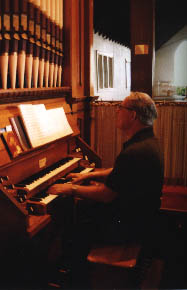 This little parish Church is located in a rather down at heel neighbourhood in the West end of Toronto, not far from the old stockyards on Pritchard Avenue. An unpretentious Church in an unpretentious setting, it contains a pleasant little organ. This seems to be an appropriate place at which to conclude this article, which hopefully is the beginning of a series on interesting pipe organs in Toronto.
This little parish Church is located in a rather down at heel neighbourhood in the West end of Toronto, not far from the old stockyards on Pritchard Avenue. An unpretentious Church in an unpretentious setting, it contains a pleasant little organ. This seems to be an appropriate place at which to conclude this article, which hopefully is the beginning of a series on interesting pipe organs in Toronto.